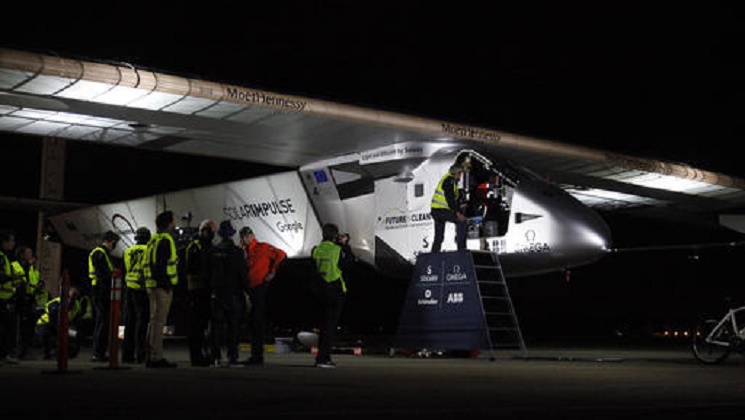
Pilot Andre Borschberg sits in the cockpit of the Solar Impulse 2, as his son, Teo Borschberg, prepares the solar powered plane at Moffett Field in Mountain View, Calif., before dawn Monday, May 2, 2016. The plane took off from California for Arizona to resume its journey around the world using only energy from the sun. AP
GOODYEAR, Ariz. — A solar-powered airplane that landed in Arizona last week after a daylong flight from California is headed to Oklahoma next on the latest leg of its around-the-world journey.
Project officials said Wednesday that the Swiss-made Solar Impulse 2 is scheduled to take off from Phoenix Goodyear Airport at 3 a.m. PDT Thursday with a destination of Tulsa International Airport.
The aircraft took off from Mountain View in northern California in the early hours of May 2 and landed at the airport southwest of Phoenix 16 hours later.
The Solar Impulse 2’s wings, which stretch wider than those of a Boeing 747, are equipped with 17,000 solar cells that power propellers and charge batteries. The plane runs on stored energy at night.
It began its globe-circling trip last year and flew from Hawaii to Mountain View last month.
After Oklahoma, the plane is expected to make one more stop in the United States before crossing the Atlantic Ocean to Europe or northern Africa, according to the website documenting the journey.
The aircraft began its voyage in March 2015 from Abu Dhabi, the capital of the United Arab Emirates, and made stops in Oman, Myanmar, China and Japan.
The plane had a five-day trip from Japan to Hawaii and three-day trip from Hawaii to California’s Silicon Valley.
The crew was forced to stay in Oahu, Hawaii for nine months after the plane’s battery system sustained heat damage on its trip from Japan.
Organizers said the layovers give the two Swiss pilots — Bertrand Piccard and Andre Borschberg — a chance to swap places and engage with local communities along the way so they can explain the project, which is estimated to cost more than $100 million.
Piccard is scheduled to be at the controls for the Arizona-to-Oklahoma leg.
The solar project began in 2002 to highlight the importance of renewable energy and the spirit of innovation. TVJ